Characteristics
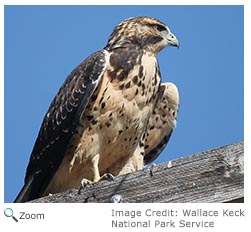 Swainson's hawk is a large hawk 18-22 inches in length with a wingspan of four feet. It is dark brown above with a lighter brown chest and a white belly. It has a short, hooked bill and slightly pointed wings. When it is perched, its wings extend beyond its tail.
Males and female look alike. Swainson's hawk is a large hawk 18-22 inches in length with a wingspan of four feet. It is dark brown above with a lighter brown chest and a white belly. It has a short, hooked bill and slightly pointed wings. When it is perched, its wings extend beyond its tail.
Males and female look alike.
Range
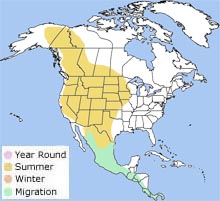 Swainson's hawk breeds from extreme western Canada south through most of the western United States and south to Mexico. It winters south to Argentina. A small number of Swainson's hawks winter in Florida. Swainson's hawk breeds from extreme western Canada south through most of the western United States and south to Mexico. It winters south to Argentina. A small number of Swainson's hawks winter in Florida.
Habitat
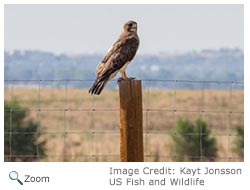 Swainson's hawk lives on open plains, prairies, agricultural areas, and other grasslands. It is often seen perched on poles and fence posts looking for prey. Swainson's hawk lives on open plains, prairies, agricultural areas, and other grasslands. It is often seen perched on poles and fence posts looking for prey.
Diet
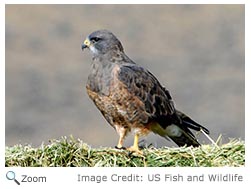 Swainson's hawk eats insects, especially
grasshoppers, crickets and locusts. It can sometimes be seen following
tractors and snatching up insects that are flushed out. In fact, it is sometimes
called the grasshopper hawk. It also eats birds, small rodents, reptiles
and amphibians. Swainson's hawk eats insects, especially
grasshoppers, crickets and locusts. It can sometimes be seen following
tractors and snatching up insects that are flushed out. In fact, it is sometimes
called the grasshopper hawk. It also eats birds, small rodents, reptiles
and amphibians.
|
|
Life Cycle
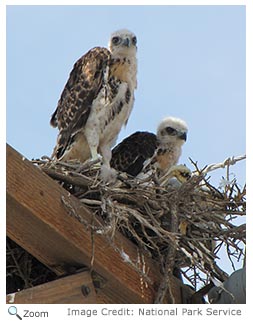 The male arrives at the breeding territory first and selects a site and builds a nest of sticks in a tree, bush, or on the ground. The female lays 2-4 eggs and incubates them. The male arrives at the breeding territory first and selects a site and builds a nest of sticks in a tree, bush, or on the ground. The female lays 2-4 eggs and incubates them.
When the female has to leave the nest to feed, the male incubates the eggs. The chicks hatch in 28-35 days and fledge when they are about a month old. The chicks first learn to hunt insects on the ground.
Behavior
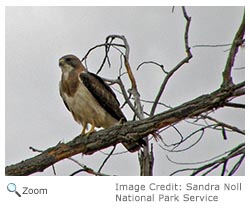 Swainson's hawks migrate in groups of
20-100 individuals. Migration begins in August and runs through October.
Most Swainson's hawks migrate to the La Pampas region in Argentina. Some
juvenile hawks may not migrate in the winter. Swainson's hawks migrate in groups of
20-100 individuals. Migration begins in August and runs through October.
Most Swainson's hawks migrate to the La Pampas region in Argentina. Some
juvenile hawks may not migrate in the winter.
|